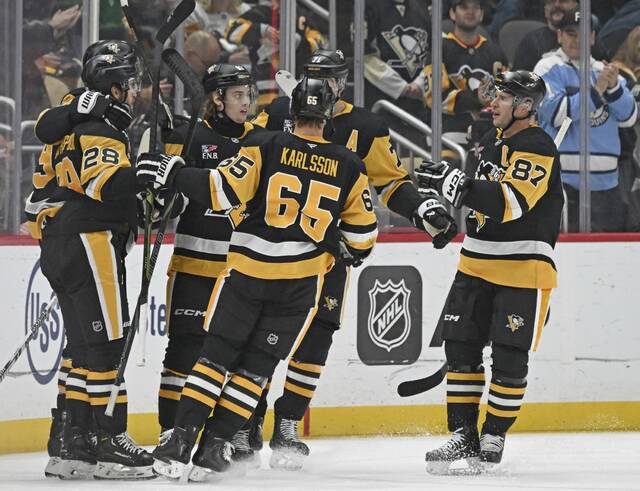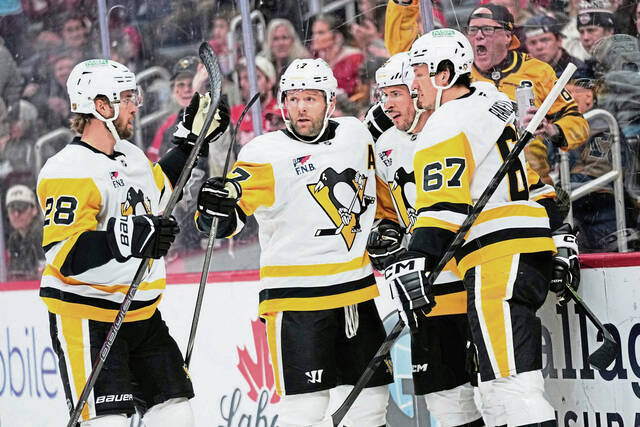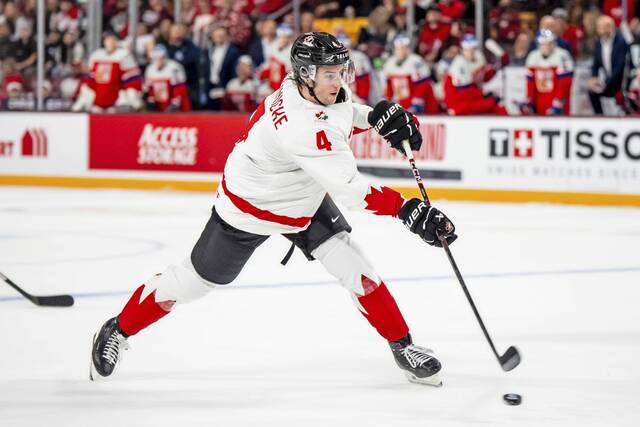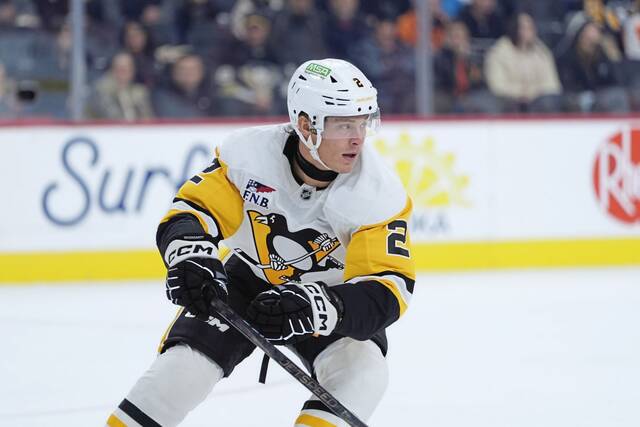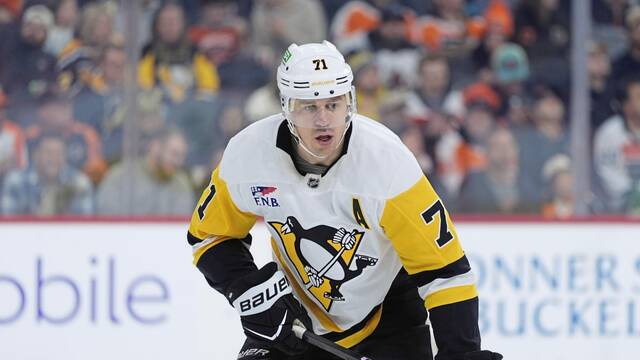While the NHL is on hold because of the ongoing coronavirus pandemic, the Tribune-Review will offer the Double Team project, an examination of the five best players who have contributed substantially to the Penguins and another franchise. For consideration, a player must have played at least the equivalent of a full season for each franchise. (Sorry, Jarome Iginla fans.)
Today, a look at the Calgary Flames, who were sparked in 1972 as the Atlanta Flames. Named after Union General William Tecumseh Sherman’s March to the Sea which torched Atlanta, the Flames were burnt out of Georgia and moved to Alberta by 1980. In 110 all-time games against the Flames, the Penguins own a 48-41-21 record.
1. Joe Mullen, right winger
One of the greatest United States-born players in NHL history, Mullen’s best years came in Canada with the Flames. Arriving in Calgary via a trade with the St. Louis Blues midway through the 1986-87 season, Mullen reached the 40-goal mark twice before reaching career-highs of 51 goals and 110 points in 1988-89.
In Calgary, Mullen won the Lady Byng Memorial Trophy twice, which recognizes a combination of gentlemanly play as well as high skill, but more importantly, he was a crucial component in helping the Flames win their only Stanley Cup title in 1989. His 16 goals led the NHL that postseason.
Little more than a year after that triumph, Mullen, then 33, was traded to the Penguins during the 1990 offseason. Joining fellow veteran newcomer Bryan Trottier, Mullen provided veteran leadership for a younger roster.
Injuries limited Mullen to 47 games and 36 points in 1990-91, but by the postseason, he was healthy enough to contribute eight goals and 17 points in 22 games as the Penguins claimed their first Stanley Cup championship.
Mullen reached the 42-goal mark in 77 games during the 1991-92 campaign, but a knee injury sidelined him for most of the postseason. Regardless, he got his name on the Stanley Cup for the third time.
After reaching the 30-goal mark twice in the next three seasons, Mullen joined the Boston Bruins as a free agent in the 1995 offseason before returning to Pittsburgh as a free agent less than a year later.
By the time he retired in 1997, the future Hockey Hall of Famer was the NHL’s career leader among American players in goals (502) and points (1,063).
2. Jean Pronovost, right winger
Acquired in a trade with the Bruins during the 1968 offseason, Pronovost was one of the Penguins’ first stars who achieved that fame by his accomplishments with the franchise rather than previous success elsewhere in the NHL.
A consistent 20- or 30-goal threat in his first four seasons with the Penguins, Pronovost, who scored the first postseason goal in the franchise’s history, erupted for 40 goals in 1973-74 and 1974-75. His greatest success came in 1975-76 when he became the Penguins’ first 50-goal scorer while playing on the famed Century Line along with Syl Apps, Jr. and Lowell MacDonald.
A four-time All-Star, Pronovost, the team’s captain in 1977-78, still holds a prominent place in the Penguins’ record book when it comes to goal-scoring marks. Only Mario Lemieux (690), Sidney Crosby (462), Jaromir Jagr (439) and Evgeni Malkin (416) have scored more goals for the franchise than Pronovost (316).
During the 1978 offseason, Pronovost was dealt to Atlanta. With the Flames, he enjoyed two steady 20-goal campaigns, including as captain in 1979-80, before moving on to the Washington Capitals by July of 1980.
3. Dan Quinn, center
Quinn was very much a product of his time. That’s to say he was a dynamic offensive center who didn’t play much defense during the free-wheeling NHL of the 1980s.
A first-round pick of the Flames in 1983, Quinn debuted in the NHL as an 18-year-old in 1983-84 and showed gradual improvement until he reached the 30-goal mark during a 1985-86 campaign which ended with a loss to the Montreal Canadiens in the Stanley Cup Final.
In November of 1986, the veteran Flames dealt the young Quinn to the Penguins for another entrant on this list, veteran forward Mike Bullard. With the Penguins, Quinn thrived as a No. 2 center behind Lemieux. While opposing defenses focused on Lemieux, Quinn took advantage of lesser defensive matchups and reached the 40-goal mark in 1987-88. His signature season of 1988-89 saw him establish a career best with 94 points in 79 games.
After the team had a poor start to the 1989-90 campaign, Quinn was shipped to the Vancouver Canucks as part of a six-player trade in January of 1990. His NHL career came to an end in 1996-97 when he signed with the Penguins and appeared in 16 games.
4. Mike Bullard, center
A first-round pick in 1980, Bullard was the Penguins’ future at the start of the decade. By 1984, he was an afterthought thanks to the arrival of Lemieux.
As a rookie in 1981-82, Bullard showed he was capable of handling the rigors of the NHL by putting up 36 goals in 75 games as a 20-year old. That postseason, he helped the Penguins nearly upset the New York Islanders in a preliminary round series.
After regressing a bit with a 22-goal campaign in 1982-83, Bullard claimed a bit of an infamous designation by being the best player on one of the worst teams in NHL history as he paced the 1983-84 Penguins, who essentially tanked to draft Lemieux, with 51 goals and 92 points in 76 games. An All-Star selection that season, not one of his goals was a game-winning score for a squad capable of only 16 victories.
Bullard was one of the few people in Pittsburgh who wasn’t thrilled with Lemieux’s arrival as it pushed him down the depth chart. Not shy to share that sentiment, Bullard was moved to the Flames for Quinn.
Spending parts of two seasons with some strong Flames teams, Bullard’s career season came in 1987-88 when he put up 103 points in 79 games.
By September of 1988, Bullard was on the move again, getting traded to the Blues.
5. Jiri Hrdina, center
Entering the NHL at age 30, the Czechoslovakian-born Hrdina only played five seasons in the NHL. But three of those seasons finished with him holding the Stanley Cup.
As geopolitical restrictions were eased in the 1980s, players behind the Iron Curtain were allowed to pursue the sport in North America. Hrdina was an established veteran for his country on the national stage. An eighth-round pick by the Flames in 1984, he made his NHL debut in 1987-88, playing in just nine games.
The next season, he showed he could handle the sport on this continent by producing 22 goals and 54 points in 70 games as a 31-year-old rookie who was mostly used in defensive situations. That spring, he helped Flames win the Stanley Cup.
By December of 1990, the Penguins wanted to aid Jagr, then an 18-year-old who spoke little English, adjust to North America and acquired Hrdina in a trade. Used primarily on the ice in bottom-six and penalty-killing roles, Hrdina’s tutelage steered Jagr into becoming one of the NHL’s greatest players.
In two seasons, Hrdina appeared in 93 games for the Penguins and only produced 36 points. But each of those seasons ended with a Stanley Cup celebration.
Following the 1992 title, he returned the newly reformed Czech Republic.
Honorable mentions: Paul Baxter, defenseman; Deryk Engelland, defenseman; Andrew Ference, defenseman; Noel Price, defenseman; German Titov, left winger.




